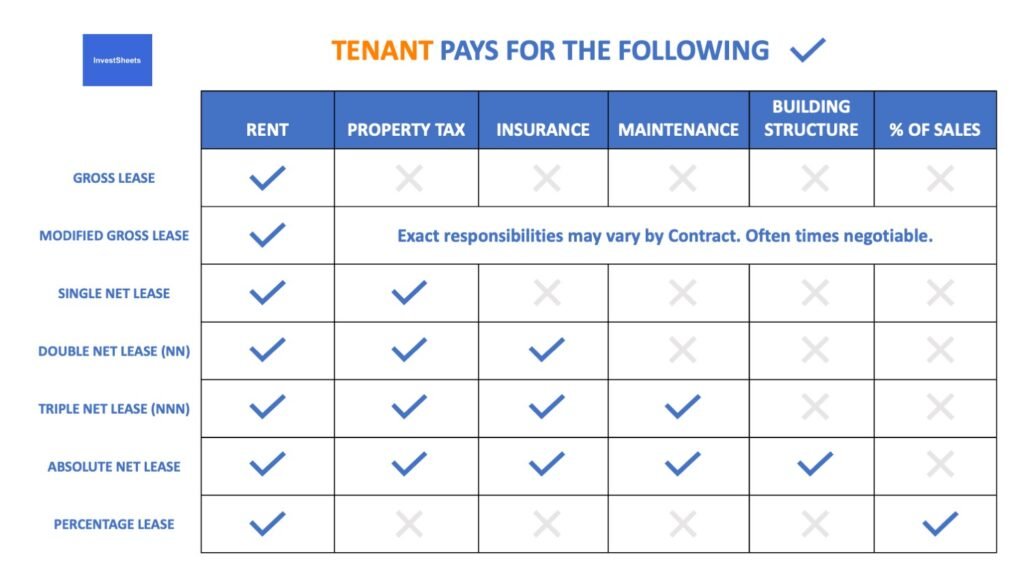
Lease structures play a pivotal role in commercial real estate, influencing both the landlord’s revenue and the tenant’s obligations. Among the various types, NNN (Triple Net), Gross, and Modified Gross leases are prevalent. Understanding these structures is crucial for investors and tenants alike. In this post, we’ll delve into each lease type, unraveling their complexities and implications.

Gross Leases:
Contrary to NNN leases, Gross leases simplify financial responsibilities for tenants. In a Gross lease, the landlord assumes most operating expenses, including property taxes, insurance, and maintenance costs. Tenants pay a fixed monthly rent, alleviating the uncertainty associated with variable expenses. Gross leases are common in office and industrial sectors, offering tenants stability and predictability in their occupancy costs. However, landlords must carefully calculate rent to ensure operational expenses are adequately covered.
Modified Gross Leases:
As the name suggests, Modified Gross leases combine elements of both NNN and Gross leases, offering a middle ground for landlords and tenants. In a Modified Gross lease, certain expenses, such as property taxes and insurance, are shared between the landlord and tenant, while others, like maintenance costs, may be negotiated separately. This hybrid structure allows for greater flexibility in lease negotiations, catering to the specific needs of both parties. Modified Gross leases are prevalent in office and medical office buildings, offering a balanced approach to cost-sharing.
Net Leases:
Net leases, allocate a varying degree of responsibility for operating expenses between landlords and tenants. In a Net lease, tenants bear the burden of property taxes and Rent. Net leases offer landlords predictable income streams while providing tenants transparency into their occupancy costs. These types of leases tend to be popular in commercial properties.
NN Leases:
An NN lease, also known as a Double Net lease, falls within the spectrum of Net leases, albeit with a nuanced allocation of expenses between landlords and tenants. In an NN lease, landlords typically cover property taxes and insurance, leaving maintenance costs to tenants. This structure provides tenants with a degree of financial predictability while allowing landlords to retain some control over property management responsibilities. NN leases are commonly found in commercial real estate settings where landlords seek to balance income stability with operational oversight.
NNN Leases:
NNN leases, also known as Triple Net leases, are popular in commercial real estate, particularly for retail properties. In an NNN lease, tenants are responsible for paying not only the base rent but also additional expenses such as property taxes, insurance, and maintenance costs. Landlords typically have minimal obligations beyond property management. While NNN leases offer landlords predictable income and reduced operational responsibilities, tenants bear the brunt of variable expenses, making lease negotiations critical.
Absolute Net Leases:
An Absolute Net lease represents the pinnacle of tenant responsibility, with tenants assuming all operating expenses, including property taxes, insurance, maintenance, and structural repairs. This lease structure offers landlords a hands-off approach to property management, ensuring consistent rental income with minimal operational involvement. Absolute Net leases are prevalent in single-tenant properties, such as fast-food restaurants and pharmacies, providing long-term stability for both parties.
Percentage Leases:
In a Percentage lease, tenants pay a base rent plus a percentage of their gross sales, often used in retail settings. This structure aligns the landlord’s income with the tenant’s business performance, incentivizing both parties to drive sales. Percentage leases offer tenants flexibility in rent payments, especially during periods of fluctuating revenues, while landlords stand to benefit from the potential upside as the tenant’s business grows.
Types of Leases

Conclusion - Lease Structures
Commercial lease structures serve as the bedrock of landlord-tenant relationships, delineating financial responsibilities and risk allocation. Whether opting for a Net lease, NN lease, Absolute NNN lease, or Percentage lease, understanding the intricacies of each structure is paramount for navigating the complexities of commercial real estate. Investsheets stands as a valuable resource, ready to assist investors, landlords, and tenants alike in analyzing their properties and making informed decisions.
With our suite of tools, including spreadsheets and templates tailored for commercial real estate analysis, we empower individuals to optimize their investments, negotiate favorable terms, and cultivate mutually beneficial partnerships. Trust Investsheets to be your partner in navigating the dynamic realm of commercial real estate with confidence and clarity.
Share with your network:
